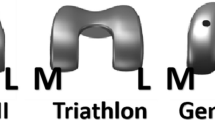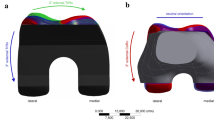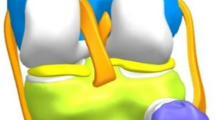Abstract
Purpose
Whether to resurface the patella in knee replacement remains a controversial issue. The geometrical design of the trochlear groove in the femoral component could play an important role in determining the stress distribution on the patellofemoral joint, but this has not been sufficiently reported on. This study attempted to determine the effect of implant design on contact mechanics by means of a finite element method.
Methods
Two designs, an anatomical V-shape design (VSD) and a dome-shape design (DSD), for the anterior trochlear surface in a contemporary femoral component were chosen for examining the contact characteristics. The use and absence of patella resurfacing was simulated. The stress and strain distribution on the patellar bone and the polyethylene component were calculated for comparison.
Results
Without patellar resurfacing, the maximal compressive strain in the patellar bone in the VSD model was about 20 % lower than the DSD model. On the other hand, with resurfacing, the maximal strain for the VSD model was 13.3 % greater than for DSD. Uneven stress distribution at the bone–implant interface was also noted for the two designs.
Conclusion
The femoral component with a V-shape trochlear groove reduced the compressive strain on the unresurfaced patella. If resurfacing the patella, the femoral component with a curved domed-shape design might reduce the strain in the remaining patellar bone. Uneven stress could occur at the bone–implant interface, so design modifications for improving fixation strength and medialization of the patellar button would be helpful in reducing the risk of peg fracture or loosening.
Level of evidence
III.







Similar content being viewed by others
References
Amis AA (2007) Current concepts on anatomy and biomechanics of patellar stability. Sports Med Arthros Rev 15(2):48–56
Anderson TL(2005) Fracture mechanics: fundamentals and applications, 3rd edn. CRC Press, Talor & Francis group, New York
Barrack RL, Bertot AJ, Wolfe MW, Waldman DA, Milicic M, Myers L (2001) Patellar resurfacing in total knee arthroplasty. A prospective, randomized, double-blind study with five to seven years of follow-up. J Bone Joint Surg Am 83(9):1376–1381
Bercovy M, Beldame J, Lefebvre B, Duron A (2012) A prospective clinical and radiological study comparing hydroxyapatite-coated with cemented tibial components in total knee replacement. J Bone Joint Surg Br 94(4):497–503
Berger RA, Crossett LS, Jacobs JJ, Rubash HE (1998) Malrotation causing patellofemoral complications after total knee arthroplasty. Clin Orthop Relat Res 356:144–153
Bhattee G, Moonot P, Govindaswamy R, Pope A, Fiddian N, Harvey A (2014) Does malrotation of components correlate with patient dissatisfaction following secondary patellar resurfacing? Knee 21(1):247–251
Boyd AD, Ewald FC, Thomas WH, Poss R, Sledge CB (1993) Long-term complications after total knee arthroplasty with or without resurfacing of the patella. J Bone Joint Surg Am 5(5):674–681
Brick GW, Scott RD (1988) The patellofemoral component of total knee arthroplasty. Clin Orthop Relat Res 231:163–178
Conditt MA, Noble PC, Allen B, Shen M, Parsley BS, Mathis KB (2005) Surface damage of patellar components used in total knee arthroplasty. J Bone Joint Surg Am 87(6):1265–1271
Fitzpatrick CK, Baldwin MA, Ali AA, Laz PJ, Rullkoetter PJ (2011) Comparison of patellar bone strain in the natural and implanted knee during simulated deep flexion. J Orthop Res 29(2):232–239
Fitzpatrick CK, Kim RH, Ali AA, Smoger LM, Rullkoetter PJ (2013) Effects of resection thickness on mechanics of resurfaced patellae. J Biomech 46(9):1568–1575
Fitzpatrick CK, Rullkoetter PJ (2012) Influence of patellofemoral articular geometry and material on mechanics of the unresurfaced patella. J Biomech 45(11):1909–1915
Francke EI, Lachiewicz PF (2000) Failure of a cemented all-polyethylene patellar component of a press-fit condylar total knee arthroplasty. J Arthroplasty 15(2):234–237
Godest AC, Beaugonin M, Haug E, Taylor M, Gregson PJ (2002) Simulation of a knee joint replacement during a gait cycle using explicit finite element analysis. J Biomech 35(2):267–275
Huang CH, Hsu LI, Lin KJ, Chang TK, Cheng CK, Lu YC, Chen CS, Huang CH (2014) Patellofemoral kinematics during deep knee flexion after total knee replacement: a computational simulation. Knee Surg Sports Traumatol Arthrosc. doi:10.1007/s00167-013-2819-y
Huang CH, Lee YM, Lai JH, Liau JJ, Cheng CK (1999) Failure of the all-polyethylene patellar component after total knee arthroplasty. J Arthroplasty 14(8):940–944
Huang CH, Liau JJ, Huang CH, Cheng CK (2007) Stress analysis of the anterior tibial post in posterior stabilized knee prostheses. J Orthop Res 25(4):442–449
Iwaki H, Pinskerova V, Freeman MA (2000) Tibiofemoral movement 1: the shapes and relative movements of the femur and tibia in the unloaded cadaver knee. J Bone Joint Surg Br 82(8):1189–1195
Kaper BP, Woolfrey M, Bourne RB (2000) The effect of built-in external femoral rotation on patellofemoral tracking in the genesis II total knee arthroplasty. J Arthroplasty 15(8):964–969
Keshmiri A, Maderbacher G, Baier C, Muller W, Grifka J, Springorum HR (2014) Do surgical patellar interventions restore patellar kinematics in fixed-bearing, cruciate-retaining total knee arthroplasty?: an in vitro study. J Arthroplasty. doi:10.1016/j.arth.2014.07.008
Kim YH, Park JW, Kim JS (2012) Comparison of the Genesis II total knee replacement with oxidised zirconium and cobalt-chromium femoral components in the same patients: a prospective, double-blind, randomised controlled study. J Bone Joint Surg Br 94(9):1221–1227
Kong CG, Park SW, Yang H, In Y (2014) The effect of femoral component design on patellar tracking in total knee arthroplasty: Genesis II prosthesis versus Vanguard prosthesis. Arch Orthop Trauma Surg 134(4):571–576
Levai JP, McLeod HC, Freeman MA (1983) Why not resurface the patella? J Bone Joint Surg Br 65(4):448–451
Li B, Bai L, Fu Y, Wang G, He M, Wang J (2012) Comparison of clinical outcomes between patellar resurfacing and nonresurfacing in total knee arthroplasty: retrospective study of 130 cases. J Int Med Res 40(5):1794–1803
Liu YL, Lin KJ, Huang CH, Chen WC, Chen CH, Chang TW, Lai YS, Cheng CK (2011) Anatomic-like polyethylene insert could improve knee kinematics after total knee arthroplasty—a computational assessment. Clin Biomech 26(6):612–619
Ma HM, Lu YC, Kwok TG, Ho FY, Huang CY, Huang CH (2007) The effect of the design of the femoral component on the conformity of the patellofemoral joint in total knee replacement. J Bone Joint Surg Br 89(3):408–412
Manopoulos P, Havet E, Pearce O, Lardanchet JF, Mertl P (2012) Mid- to long-term results of revision total knee replacement using press-fit intramedullary stems with cemented femoral and tibial components. J Bone Joint Surg Br 94(7):937–940
McNamara JL, Collier JP, Mayor MB, Jensen RE (1994) A comparison of contact pressures in tibial and patellar total knee components before and after service in vivo. Clin Orthop Relat Res 299:104–113
Merican AM, Ghosh KM, Baena FR, Deehan DJ, Amis AA (2014) Patellar thickness and lateral retinacular release affects patellofemoral kinematics in total knee arthroplasty. Knee Surg Sports Traumatol Arthrosc 22(3):526–533
Merican AM, Ghosh KM, Iranpour F, Deehan DJ, Amis AA (2011) The effect of femoral component rotation on the kinematics of the tibiofemoral and patellofemoral joints after total knee arthroplasty. Knee Surg Sports Traumatol Arthrosc 19(9):1479–1487
Miller MC, Berger RA, Petrella AJ, Karmas A, Rubash HE (2001) Optimizing femoral component rotation in total knee arthroplasty. Clin Orthop Relat Res 392:38–45
Pilling RW, Moulder E, Allgar V, Messner J, Sun Z, Mohsen A (2012) Patellar resurfacing in primary total knee replacement: a meta-analysis. J Bone Joint Surg Am 94(24):2270–2278
Reilly DT, Burstein AH (1975) The elastic and ultimate properties of compact bone tissue. J Biomech 8(6):393–405
Reilly DT, Martens M (1972) Experimental analysis of the quadriceps muscle force and patello-femoral joint reaction force for various activities. Acta Orthop 43(2):126–137
Saffarini M, Ntagiopoulos PG, Demey G, Le Negaret B, Dejour DH (2014) Evidence of trochlear dysplasia in patellofemoral arthroplasty designs. Knee Surg Sports Traumatol Arthrosc 22(10):2574–2581
Schindler OS (2012) Basic kinematics and biomechanics of the patellofemoral joint part 2: the patella in total knee arthroplasty. Acta Orthop Belg 78(1):11–29
Singerman R, Gabriel SM, Maheshwer CB, Kennedy JW (1999) Patellar contact forces with and without patellar resurfacing in total knee arthroplasty. J Arthroplasty 14(5):603–609
Stäubli H, Schatzmann L, Brunner P, Rincón L, Nolte L (1999) Mechanical Tensile Properties of the quadriceps tendon and patellar ligament in young adults. Am J Sports Med 27(1):27–34
Steinbruck A, Schroder C, Woiczinski M, Fottner A, Muller PE, Jansson V (2014) The effect of trochlea tilting on patellofemoral contact patterns after total knee arthroplasty: an in vitro study. Arch Orthop Trauma Surg 134(6):867–872
Takahashi A, Sano H, Ohnuma M, Kashiwaba M, Chiba D, Kamimura M, Sugita T, Itoi E (2012) Patellar morphology and femoral component geometry influence patellofemoral contact stress in total knee arthroplasty without patellar resurfacing. Knee Surg Sports Traumatol Arthrosc 20(9):1787–1795
Takahashi A, Sano H, Ohnuma M, Kashiwaba M, Chiba D, Kamimura M, Sugita T, Itoi E (2012) Patellar morphology and femoral component geometry influence patellofemoral contact stress in total knee arthroplasty without patellar resurfacing. Knee Surg Sports Traumatol Arthrosc 20(9):1787–1795
Takeuchi T, Lathi VK, Khan AM, Hayes WC (1995) Patellofemoral contact pressures exceed the compressive yield strength of UHMWPE in total knee arthroplasties. J Arthroplasty 10(3):363–368
Thompson JA, Hast MW, Granger JF, Piazza SJ, Siston RA (2011) Biomechanical effects of total knee arthroplasty component malrotation: a computational simulation. J Orthop Res 29(7):969–975
Thompson NW, Ruiz AL, Breslin E, Beverland DE (2001) Total knee arthroplasty without patellar resurfacing in isolated patellofemoral osteoarthritis. J Arthroplasty 16(5):607–612
van Jonbergen HP, Reuver JM, Mutsaerts EL, Poolman RW (2014) Determinants of anterior knee pain following total knee replacement: a systematic review. Knee Surg Sports Traumatol Arthrosc 22(3):478–499
Verlinden C, Uvin P, Labey L, Luyckx JP, Bellemans J, Vandenneucker H (2010) The influence of malrotation of the femoral component in total knee replacement on the mechanics of patellofemoral contact during gait: an in vitro biomechanical study. J Bone Joint Surg Br 92(5):737–742
Whiteside LA, Nakamura T (2003) Effect of femoral component design on unresurfaced patellas in knee arthroplasty. Clin Orthop Relat Res 410:189–198
Xu C, Chu X, Wu H (2007) Effects of patellar resurfacing on contact area and contact stress in total knee arthroplasty. Knee 14(3):183–187
Yoshii I, Whiteside LA, Anouchi YS (1992) The effect of patellar button placement and femoral component design on patellar tracking in total knee arthroplasty. Clin Orthop Relat Res 275:211–219
Youm YS, Cho WS, Woo JH, Kim BK (2010) The effect of patellar thickness changes on patellar tilt in total knee arthroplasty. Knee Surg Sports Traumatol Arthrosc 18(7):923–927
Zienkiewicz OC, Zhu JZ (1987) A simple error estimator and adaptive procedure for practical engineerng analysis. Int J Numer Method Biomed Eng 24(2):337–357
Acknowledgments
The authors are pleased to acknowledge the financial support of the Ministry of Science and Technology in Taiwan (MOST 100-2221-E-195-001-MY2 and MOST 102-2221-E-195-001). We particularly thank Colin J. McClean for his kind assistance in language editing and proofreading of this manuscript.
Author information
Authors and Affiliations
Corresponding authors
Additional information
Chang-Hung Huang and Lin-I Hsu have contributed equally to this article.
Rights and permissions
About this article
Cite this article
Huang, CH., Hsu, LI., Chang, TK. et al. Stress distribution of the patellofemoral joint in the anatomic V-shape and curved dome-shape femoral component: a comparison of resurfaced and unresurfaced patellae. Knee Surg Sports Traumatol Arthrosc 25, 263–271 (2017). https://doi.org/10.1007/s00167-014-3485-4
Received:
Accepted:
Published:
Issue Date:
DOI: https://doi.org/10.1007/s00167-014-3485-4




